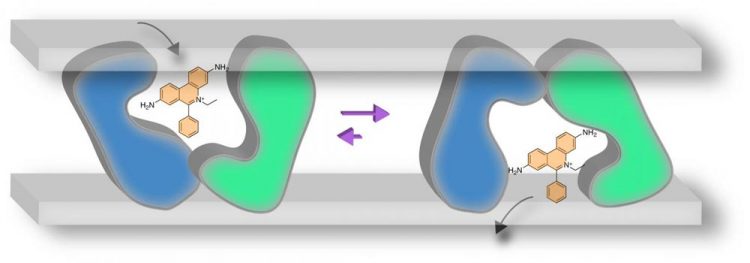Single mutation dramatically changes structure and function of bacteria's transporter proteins

Schematic showing the two protein subunits (blue and green) of a simple transporter in E. coli changing the direction of its opening so it can pump a toxic compound (orange) across the cell's membrane (grey). Credit: Nathaniel Traaseth and Ampon Sae Her (CC BY 4.0)
Swapping a single amino acid in a simple bacterial protein changes its structure and function, revealing the effects of complex gene evolution, finds a new study published in the journal eLife.
The study–conducted using E. coli bacteria–can help researchers to better understand the evolution of transporter proteins and their role in drug resistance.
“We were quite surprised by how minor mutations can influence the structure and function of transporter proteins,” said Nate Traaseth, associate professor of chemistry at New York University and the study's senior author.
Cells are bound by a thin membrane layer that protects its interior from the outside environment. Within this layer are transporter proteins that control which substances are allowed in and out of the cell. These transporters actively move substances across the cell membrane by loading cargo on one side of the layer, then changing their structure to release it on the other side.
Membrane transporters are typically made up of multiple repeating units. In more complex transporters, the genetic sequence for each of these structural units is fused together into a single gene that codes for the protein.
It is thought that the repeated pattern evolved from smaller membrane protein genes that had duplicated and fused together. But are there evolutionary advantages to having more complex transporters being produced from a single, fused gene?
To investigate this, Traaseth and colleagues Maureen Leninger and Ampon (Callie) Sae Her in NYU's Department of Chemistry examined a simple transporter found in E. coli bacteria, which is plentiful in human and animal intestines. However, some strains of E. coli can cause serious illness and are increasingly resistant to antibiotics, which occurs when they pump out toxic compounds using transporters in their membrane.
The E. coli transporter, called EmrE, contains two identical protein subunits that work together to move toxic molecules across the membrane and eliminate them from the cell.
Experiments revealed that changing a single amino acid–the building blocks that make up proteins–in one of the two protein subunits to make them slightly different from each other dramatically modified the transporter's structure and function. The subtle amino acid swap disrupted the balance of inward- and outward-facing proteins.
Importantly, changing the single amino acid altered the transporter's ability to remove toxic chemicals from E. coli and reduced the bacteria's resistance to drugs–which may have future implications for drug development and combating antibiotic resistance.
“While the clinical application of these findings is a few steps away, understanding the evolution of drug transporters gives us new insight into how Mother Nature may harness mutations to provide drug resistance,” said Traaseth.
The researchers note that the effects of a minor change to one of the identical halves of the EmrE transporter demonstrates how sensitive membrane transporters are to mutations.
“This observation could also help explain why evolution favored more complex transporters comprised of fused genes in which single amino acid changes can alter how the transporter operates,” added Traaseth.
###
The research was supported by the National Institutes of Health (R01 AI108889 and S10OD016343) and National Science Foundation (MCB 1506420).
Media Contact
All latest news from the category: Life Sciences and Chemistry
Articles and reports from the Life Sciences and chemistry area deal with applied and basic research into modern biology, chemistry and human medicine.
Valuable information can be found on a range of life sciences fields including bacteriology, biochemistry, bionics, bioinformatics, biophysics, biotechnology, genetics, geobotany, human biology, marine biology, microbiology, molecular biology, cellular biology, zoology, bioinorganic chemistry, microchemistry and environmental chemistry.
Newest articles

Silicon Carbide Innovation Alliance to drive industrial-scale semiconductor work
Known for its ability to withstand extreme environments and high voltages, silicon carbide (SiC) is a semiconducting material made up of silicon and carbon atoms arranged into crystals that is…

New SPECT/CT technique shows impressive biomarker identification
…offers increased access for prostate cancer patients. A novel SPECT/CT acquisition method can accurately detect radiopharmaceutical biodistribution in a convenient manner for prostate cancer patients, opening the door for more…

How 3D printers can give robots a soft touch
Soft skin coverings and touch sensors have emerged as a promising feature for robots that are both safer and more intuitive for human interaction, but they are expensive and difficult…





















